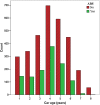Antilock braking system effectiveness in prevention of road traffic crashes in Iran
- PMID: 23642097
- PMCID: PMC3649935
- DOI: 10.1186/1471-2458-13-439
Antilock braking system effectiveness in prevention of road traffic crashes in Iran
Abstract
Background: Anti-lock Brake System (ABS) helps the equipped vehicles to stop under heavy braking, in a shorter distance and with a better control of direction. It was expected that this technology will reduce the rate of fatal road traffic crashes (RTC); however, the outcome is controversial in the real world. The aim of this study is to compare the claimed annual incidence rate and financial losses due to RTCs in ABS vs. non-ABS personal vehicles in Iran.
Methods: A telephone survey among drivers of two similar models of personal vehicles was arranged. The studied vehicles were of the same brand and type; but only one of them was equipped with ABS. The number of RTCs, subsequent financial loss, and drivers' knowledge and perception about ABS were sought. The sample consisted of drivers of 1232 ABS and 3123 non-ABS vehicles.
Results: The annual incidence rate of RTC involving another vehicle was 145.1 (134.8-155.9) per 1000 vehicle-years and there was not a statistically significant difference between study groups.The incidence of RTC with another vehicle due to brake failure was 50.3 (42.9-58.5) for 1000 non ABS vehicle-years and 30.0 (21.2-41.2) for 1000 ABS equipped vehicle-years. The difference was statistically significant after adjustment for the driver and vehicle's age and the daily driving time. The attributable risk of RTC for non-ABS vehicles was 20/1000 vehicles and the excess fraction was 39.8%. The mean financial loss due to reported RTCs was $987.9 ± $1547.3 US Dollars and there was not a statistically significant difference between study groups. While 61.1% of ABS vehicle drivers reported situations in which they believed the ABS had prevented a crash, 44.1% of them however, they did not know how to use ABS efficiently.
Conclusions: Law enforcement to maintain safe distance and adhere to speed limit while driving, is needed to raise the effectiveness of ABS. This is as necessary as considering mandatory outfitting of ABS. Safety authorities should first consider the global experience and local evidence, before adopting any specific policy in this regard. The drivers need to learn the right way to use ABS for maximum effectiveness.
Figures
References
-
- Peden M, Scurfield R, Sleet D, Mohan D, Hyder A, Jarawan E, Mathers C. World report on road traffic injury prevention. Geneva: World Health Organization; 2004.
-
- Ardalan A, Masoomi G, Goya M, Sarvar M, Haddadi M, Miadfar J, Rezvani F, Shahmoradi M. Road traffic injuries: a challenge for Iran’s health system. Iranian J PublHealth. 2009;38(Suppl. 1):98–101.
-
- Boswell MT, Burnham KP, Patil GP. In: Handbook of Statistics. Volume 6. Krishnaiah PR, Rao CR, editor. New York, NY: Elsevier; 1988. Role and use of composite sampling and capture-recapture sampling in ecological studies; pp. 469–488.
Publication types
MeSH terms
LinkOut - more resources
Full Text Sources
Other Literature Sources
Medical


